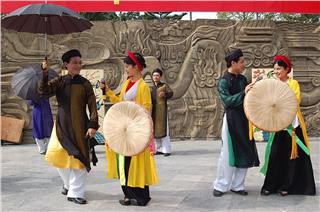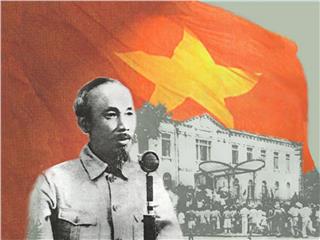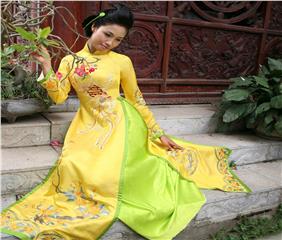Fri, 10 Apr 2015 . Last updated Thu, 18 Jun 2015 14:36









Each region has its own distinctive cultural features that make expatriates turn their hearts towards. It seems that everything: trees, rice plants, alleys and kind faces. Those cultural features characterized the time, bring their own messages, depositing in people’s soul. They are precious spiritual values that have been passed down from generation to generation creating sustainability for the past and the fulcrum for the future.
Through the ups and downs, Vietnamese folk music still keeps its special vitality in people’s soul. It is the melody of Vietnamese people’s soul, is simple, rustic but elegant. Folk music was created in the labor process, from their love for the countryside. Vietnamese farmers composed songs themselves to find the balance and the sublimation in the ups and downs of the life.
“Xam” singing also was born in such a way. In the past, in the Northern regions such as Thanh Hoa, Ninh Binh, Nam Dinh, Bac Giang, Hanoi and Hai Phong, the blinds considered “xam” as one job to earn their living. “Xam” singing is a genre of art that shows people’s feelings associated with the contemporary society. Since its appearance, “xam” singing has known for many different names such as “hat rong” and “hat dao” (singing in public places). Performers of “xam” singing have been called “anh xam” (brother), “chi xam” (sister).
“Xam” singing appeared in the reign of Tran dynasty. It is associated with folk legend. Tran Quoc Tuan and Tran Quoc Dinh were two princes of King Tran Thanh Tong. Tran Quoc Dinh was intelligent, dutiful and versatile prince, so his father loved him very much. Tran Quoc Toan was envious of him. In a competition to seek precious gems in the forest, Toan harmed his brother. Tran Quoc Toan blinded Tran Quoc Dinh and took his gem. Walking up with blind eyes, Tran Quoc Dinh wailed in pain and fainted. A fairy appeared in his dream teaching him how to make a monochord and play it.
When he got up, he found the belief to live. He groped to make the monochord and played it and sand to show his feelings. Strangely, birds were attracted by that sound. They swooped down to hear it and brought fruits for him. After that, people heard that sound. They found him then brought him their village. Here, Tran Quoc Dinh taught the music for the blinds, the poor. Hearing the rumor about his music, the king invited him to sing for royal people. And the king recognized his lost son. Back to his imperial life, Tran Quoc Dinh continued to play the music for the life and taught people to sing to earn their living. “Xam” singing appeared and Tran Quoc Dinh is considered as the ancestor of “xam” singing.
To show their gratitude to his devotion, people have taken February 22nd and August 22nd of the lunar month as his anniversary and the anniversary of Vietnamese “xam” singing. The story about the origin of “xam” singing is meaningful and beautiful like a fairy tale. Through that story, people can see the contrast of the life between rich and poor, between kindness and cruelty and between good and evil, and get a lesson about causality.
Through the story about the miserable prince, people see the wishes and hopes of “xam” singing artists. “Xam” singing expresses feelings of those who live in difficulties but are optimistic. Although they are folk artists, they help the common people feel the melodies of the life. Therefore, once listening to “Xam” singing, people will be fascinated by it. “Xam” singing artists sing the songs not only about their destiny but also about the way of the world. “Xam” singing features all aspects in life from parents' kindness, love, brotherly love, private affection and people’s bad habits and evils.
“Xam” singing is also inspired by folk songs of the Northern region such as “trong quan”, “hat vi”, “Quan ho” singing. It originates from the daily life, is the voice of people’s soul and feelings and unfortunate ones. That’s why “xam” singing is loved by most of people. Many Vietnamese researchers of folk music, the blinds have created outstanding melodies for this kind of music. Their songs express people’s feelings. To meet the audience’s demand, the singers have to perform songs with deeper content.
Over the past 700 years, the precise origin of “xam” singing have not been determined yet, but the soul and spirit of “xam” singing is always flowing through the songs, and enchanting melodies of the monochord. This genre of music is always associated with those who perform on a sedge mat with monochords and conical hats. However, it is in no way inferior thanks to its attractive performing style. Although old “xam” songs are associated with the livelihood of the blinds and the hardships of farmers, they are literary. These old songs, with academic lyrics and the strictness are not too hard to understand.
In the feudal period, “xam” singing is considered as a popular traditional genre of art. It was not only a means of subsistence of the blinds but also an entertainment activity of farmers after harvest time. This means of subsistence made “xam” singing become the music genre of qualified beggars. They used their voice, instruments and songs to condemn, protest the class oppression and bad evils in the society. Also, they raised their voice to defend the unfortunate and poor ones. Their singing talent was like a gift that compensates for their defects. It was also seen as a special spiritual food of common people.
“Xam” singing is seen as a genre of music rich in the humanity and community, so it does not take place separately. “Xam” singing group is closer to the working life. This partly shows the origin and meaning of Vietnamese traditional culture, explains why folk music becomes the unique national heritage containing the soul of the country.
Source: VTC10 - NETVIET

 Đặt vé máy bay cho người Việt?
Bấm vào đây
Đặt vé máy bay cho người Việt?
Bấm vào đây
Our service uses cookies for technical, analytical and marketing purposes. See our Cookie và Privacy policies for more information. If you agree to this, just keep browsing.


